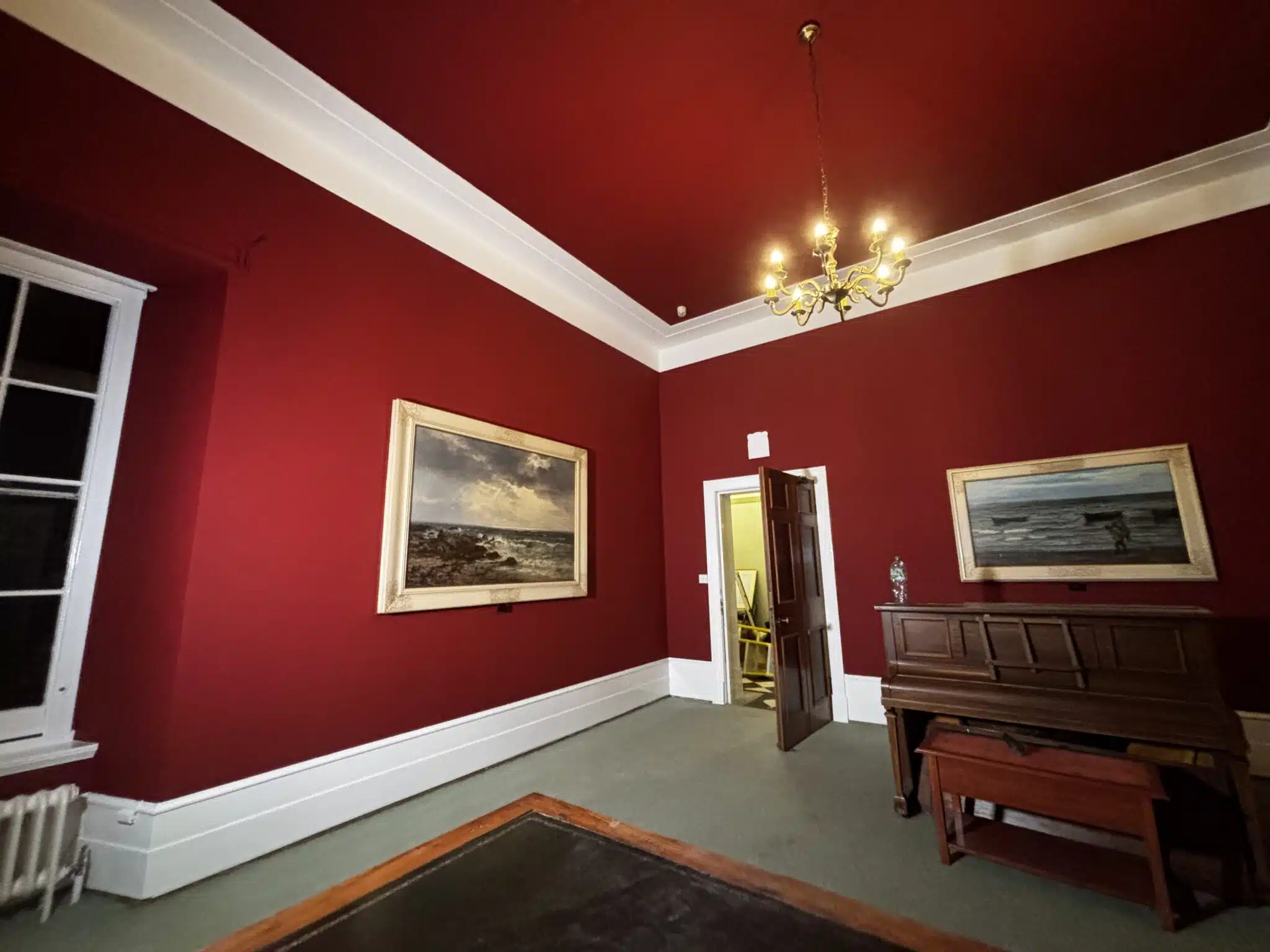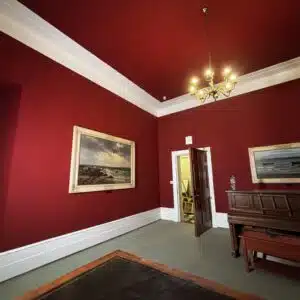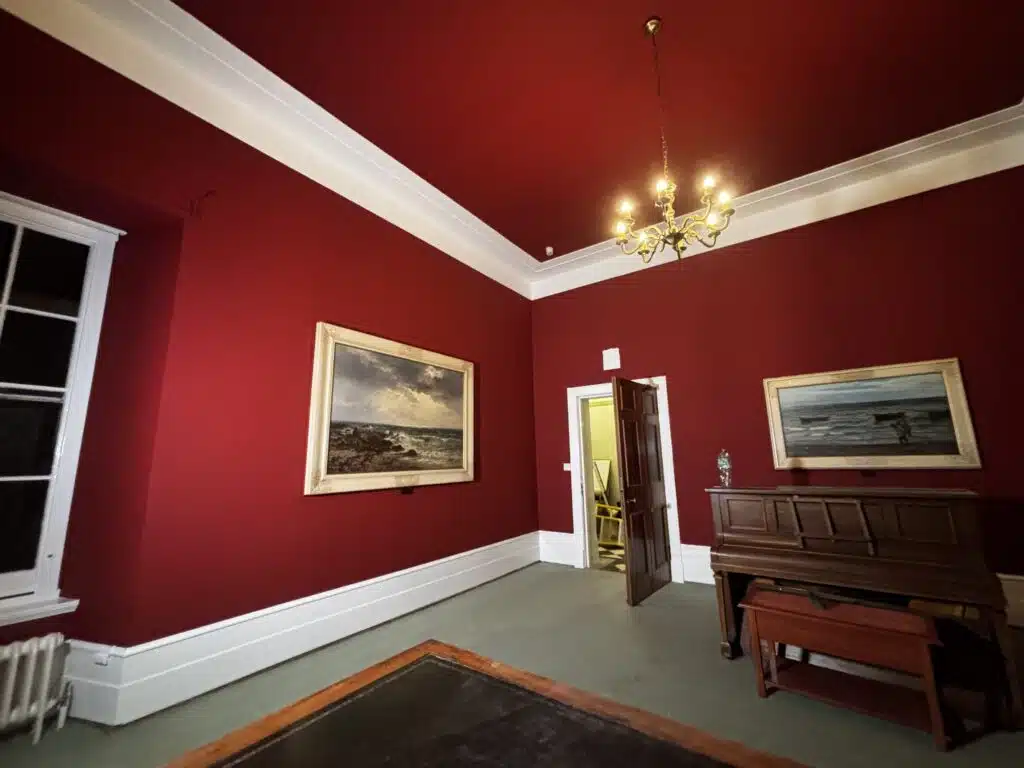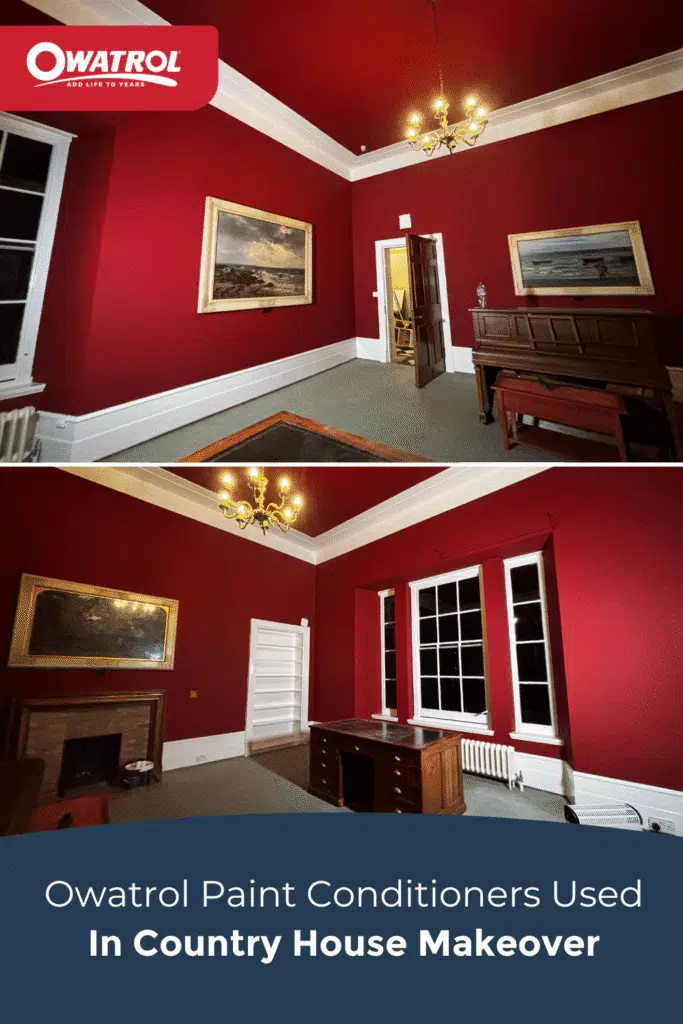This stunning country house in Scotland had a room recently finished with a helping hand from Owatrol paint conditioners.
The Project
The room was completed by Kyall of West End Decorators and is part of the beautiful Burn estate that is set in 200 acres that was gifted to the Goodenough College.
Watch him transform the space in the below video:
Here’s what Kyall had to say about Owatrol and the project:
The first time I encountered Owatrol was at my local supplier’s ‘Crown Decorating Centre’. It was a hot summer and I was painting a dark green wall which was drying as fast as it was being applied. I wanted to minimise streaks and keep the wet edge of the emulsion as it dried.
That’s when I picked up my first product, Floetrol, which worked perfectly. It held the wet edge and minimised streaks. Ever since, it’s been my go-to in all conditions.
I started using Floetrol on high streak areas, such as rooms with deep colours like reds, greens and blues, as well as long hallways and corridors.
When I wanted to achieve the best finish possible with oil-based gloss, I introduced Owatrol Oil. Glossing can be tricky, as no one likes brush strokes or roller marks (the orange peel effect). The best finish is a flat mirror-like finish, which is the purpose of gloss.
Owatrol Oil helps keep a working time with oil-based gloss and even out brush strokes if you take the right steps. For example, you need to get the paint to the correct temperature, mix the correct amount of Owatrol Oil to the undercoat and gloss and follow the recommended ratios.
For the undercoat, I usually use 25% as it dries quicker than topcoats. For the topcoat, I use 20% to help with the flow and viscosity.
Something I’d like to add is that when painting with flat matt emulsion, the result is most commonly chalky or streaky, especially in large, brightly lit areas and ceilings. Regardless of how well you lay off with the roller, you can still pull the paint off the wall as you’re applying it, which adds to the streaks.
In these cases, I tend to use a 2% matt emulsion, like Johnstone’s Perfect Matt and mix 10% Floetrol. Adding this ratio will allow you to blend and feather the paint, help it dry evenly and improve the flow of the paint when applying it.
I’d also like to mention that using conventional thinners like water for water-based paints and white spirit for oil-based paints can be damaging. This affects the pigments and integrity of the paint. For example, many decorators pour their emulsion in a tray and then thin their cutting-in material with water, which can be noticeable during the finishing process. Floetrol and Owatrol Oil are effective solutions to address these issues.
Red Room Project
This project was completed at The Burn in Edzell, Scotland. It’s a Grade B Listed Georgian mansion in the countryside that was gifted to Goodenough College. I’ve been painting in this building for over two years now, going room by room and corridor by corridor, bringing it back to standard as it was long overdue for some decoration work.
On this specific room, we chose to use Little Greene Paint Company in Bronze Red (No. 15), mixed in Johnstone’s Perfect Matt which has a 2% sheen. To start the process, I primed the walls with a grey emulsion and added 5% Owatrol Floetrol. When it came to applying the red paint, I added between 10-15% Floetrol to ensure the paint held wet edges longer and blended as the room was very large.
I cut in with a brush and then rolled out the brushstrokes with a 4” roller throughout the full room. I then proceeded to roll the walls with an 18” Purdy Colossus roller to apply the best coat of paint possible. I repeated the process on the second coat, except this time I rolled the ceiling then one wall at a time to prevent banding. Another thing to mention is that the Floetrol is very effective at reducing the effect of banding on deep colours.
Now, when painting the woodwork, I sanded with 120-grit paper and then 240-grit paper using my Mirka Sand/Extract machine. We used Tikirula Otex (undercoat) and Miranol (gloss), which is an oil-based product. The ratios I used were 25% Owatrol to the Otex because the undercoat dries very quickly, so it holds the wet edge longer. When glossing the woodwork, I applied 20% Owatrol oil.
A very important thing to add is that when glossing and achieving a flat mirror finish, it’s always best to lay off with a laying-off brush. The Owatrol is crucial in achieving this finish and holding the wet edge, improving the viscosity of the paint and it is also non-damaging to the paint.
Huge thank you to Kyall for using Owatrol paint conditioner in this amazing project and for collaborating on this post together. You can follow Kyall on the following social channels:
Why use Owatrol paint conditioners?
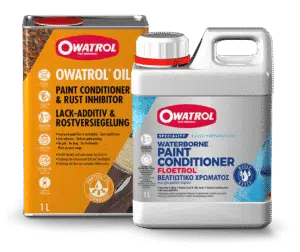
That’s where Owatrol paint conditioners shine. Trusted by both professionals and DIY-ers alike, Owatrol’s innovative solutions take your paint’s performance to the next level: improving the flow, adhesion, coverage and durability, in ways that can’t be matched by using paint alone.
The biggest and arguably best benefit of using an Owatrol paint conditioner, is it’s ability to eliminate brush and roller marks. It does this by improving the flow and levelling of the paint, to help achieve a silky smooth finish, without dragging or streaking. Whether you’re working with oil-based or water-based paints, Owatrol ensures a uniform application that looks polished and professional – even if you’re not!
Whether you’re painting walls, metal, wood, furniture, or even concrete, Owatrol paint conditioners are versatile across all project types. They improve paint penetration, especially on porous or chalky surfaces, ensuring stronger adhesion and long-term durability.
Key Points on using Owatrol paint conditioners:
- Improves the paint flow and maintains the wet edge – helping you to paint effortlessly
- Significantly reduces brush and roller marks
- Eases application of painting in difficult conditions such as high or low temperatures
- When used in a paint sprayer, allows up to 20% reduction in pressure without affecting the spray pattern or performance
- Owatrol Oil gives the paint rust-inhibiting properties and helps prevent rust on painted surfaces
Unlike damaging paint thinners or water, our paint conditioners do all this without affecting the inherent qualities of the paint or colour.
We hope you found this post on Owatrol paint conditioners interesting. If you have any other advice or top tips, please feel free to leave them in the comments below. We love hearing from you!
You can also follow Owatrol UK on Twitter, Facebook, Instagram, Pinterest or TikTok at @OwatrolUK or join the conversation at #OwatrolUK

